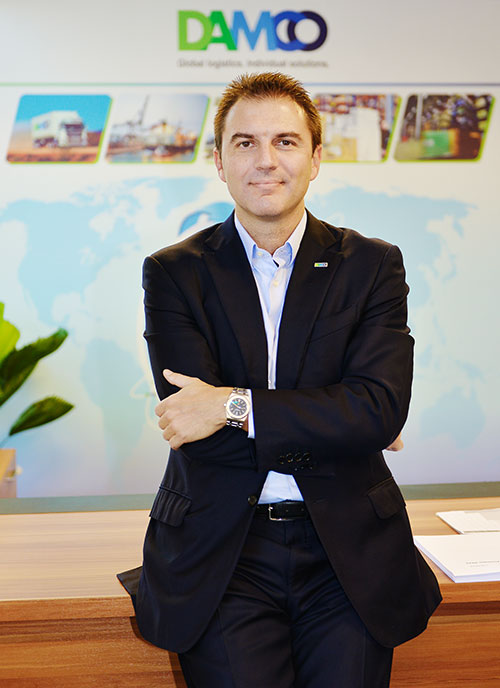Damco expects FTA export surge
 Was 2015 a successful year for Damco Vietnam?
Was 2015 a successful year for Damco Vietnam?
The 2015 results for Damco Vietnam were extremely positive as we witnessed substantial growth across all of our core products, such as supply chain management, air, ocean, contract logistics, and local services. Our business continues to diversify as we gain considerable market shares in air freight and ocean freight to balance our traditional dominant position on supply chain management. Absolutely crucial to our success is our highly-engaged workforce, and we succeeded in creating a better working environment by improving all our Employee Engagement Score parameters. This resulted in us having an overall attrition rate much lower than local market estimates. Increased investment in training and development for our colleagues, including overseas assignments, will ensure we can provide adequate career growth visibility to our staff.
What is the plan for 2016?
The plan for 2016 is centered on preparing Damco Vietnam to manage the anticipated upsides from the impact of known trade agreements such as the Trans-Pacific Partnership (TPP) and the EU-Vietnam Free Trade Agreement (FTA). We are investing substantially to participate in the global transformational project ‘Operational Excellence’, which applies lean management techniques in our operational departments – essentially to work smarter instead of harder. Besides being a very important and motivating training programme for our staff, this initiative will help us to keep a lean structure that is as productive as possible, while ensuring a constantly-improving customer experience. Specific products such as cross-border trucking between Vietnam, Cambodia, Thailand, and China will have high demand as a result of the ASEAN and our 3PL (third-party logistics) role is the fundamental enabler for our customer’s strategies. This will be more important than ever during strong business growth, which may occur within a relatively short time-frame, and as such entails potential operational risks which need to be carefully anticipated and managed successfully.
FTAs are going to make sourcing in apparel, footwear, and agricultural products from Vietnam more attractive, thus increasing Vietnam’s exports in these sectors. These sectors are among Damco’s Vietnam main areas of business. How are you going to meet the increasing demand of companies in these sectors?
Simply put, we are building scalable capacity while focusing on talent management, as we see these as the two pillars of our present and future success. In terms of the anticipated increase in demand, we have state-of-the-art warehouses in key sourcing locations in Vietnam, and can offer various value-added activities within our facilities for the benefit of our clients. When we think of building capacity to meet the demand, we have to include our key overseas trading partners – especially Europe, the US, Japan, and China – as they collaborate with our customers to ensure a smooth service is delivered end-to-end. In regards to nurturing and managing our local talents, we are increasing the quality of our training and development, and we encourage overseas assignments so our staff can benefit from the necessary international exposure which will become more and more a prerequisite for career development and enhanced knowledge of global supply chain dynamics. The combination of these elements – of domestic logistics capacity, international trade-lane efforts, and focusing on our local workforce – will enable Damco Vietnam to be ready to capitalise on the many opportunities derived from the TPP and FTAs.
Many foreign freighters have come to Vietnam recently or expanded business here to cash in on the FTAs. How is this going to change the sector?
It is a positive development to have more air freight capacity in the Vietnamese market so that we can offer more options to our customers. Increased competition in the carrier market will enhance the overall service quality and cost competitiveness. In addition to airlines, we are witnessing more 3PLs recently opening their own offices and investing in the upgrade of their facilities in both Vietnam and Cambodia. This is a clear sign that the market sees Vietnam, in particular, as probably the biggest opportunity in Southeast Asia, based on anticipated volume increases expected between 2017 and 2018. In general, more competition is beneficial for our customers who will only do business with the best service provider who is able to operate in full compliance with international standards while delivering quality at a fair price.
What the stars mean:
★ Poor ★ ★ Promising ★★★ Good ★★★★ Very good ★★★★★ Exceptional
Latest News
More News
- Can Tho utilises its growth advantages (December 15, 2025 | 09:09)
- Ca Mau unlocking potential to shape a more sustainable future (December 15, 2025 | 09:02)
- MoF workshop highlights mounting concerns over ODA on-lending costs (December 12, 2025 | 16:05)
- National Assembly approves pilot mechanisms to accelerate major projects in Hanoi (December 12, 2025 | 11:29)
- Legislation gives government flexibility for loan guarantees (December 11, 2025 | 18:04)
- Vietnam eases policy approval requirements, simplifies foreign and outbound investments (December 11, 2025 | 17:53)
- Vietnam masters core technologies of automobile value chain (December 11, 2025 | 17:46)
- VAL opens second line of largest soybean crushing complex in Southeast Asia (December 11, 2025 | 12:08)
- Vietnam urged to shore up supply-chain resilience amid global uncertainty (December 10, 2025 | 18:47)
- Unpacking new momentum in Vietnam’s M&A market (December 10, 2025 | 09:59)

















 Mobile Version
Mobile Version